World History
The Taira-Minamoto wars, which led to the firm establishment of the shogunate as Japan’s military government, began in the middle of the 12th century. At this time power in Japan was almost evenly divided between two families of feudal nobility, or the daimyo class, the Taira and the Minamoto.
Save for an allegiance to the emperor, more often acknowledged tacitly rather than in reality, both families began to see Japan as a prize to be fought over. The Fujiwara clan, whom both the Taira and Minamoto sought to replace, had been a power in Japan since the seventh century, serving as regents for the imperial dynasty.
Sensing a waning of the Fujiwara’s ability to rule, the Taira and Minamoto mustered their forces. The Taira and Minamotos had one qualitative edge: Whereas the Fujiwaras were largely cultivated court nobles, the Taira and Minamoto were daimyo from the rough samurai military class, the professional warriors of Japan, who followed “the Way of the Horse and the Bow.â€
In 1156, the first skirmishes took place in the Taira-Minamoto struggle when the clans fought in both sides of an imperial succession dispute known as the Hogen incident, named for the year it took place.
The side led by Taira Kiymori won out. Ironically he owed his place of power to Minamoto Yoshitomo, who lost his father and brother on the opposing side against the Tairas. The grief-stricken Yoshitomo declared, “A man could not live under the same heaven as the murderer of his father.â€
In 1160 in the Heiji rebellion, named again for the year it took place, Minamoto Yoshitomo gathered his knights, his samurai, and his footsoldiers, or ashigaru. The fighting raged in the imperial capital of Kyoto and featured some of the most brutal warfare yet seen among the Japanese.
The entire capital became a battleground, in which the highlight was the Minamoto’s assault on the Sanjo Palace. In one such battle, “wild flames filled the heavens, and a tempestuous wind swept up clouds of smoke.
The nobles, courtiers, and even the ladies in waiting of the women’s quarters were shot down [by arrows] or slashed to death.†Taira Kiyomori gained the upper hand, and the bloodied Minamoto retreated east to the region around Edo, modern Tokyo.
Taira Kiyomori began a purge of the Minamoto, hoping to kill off the opposing clan. However he left, as Stephen R. Turnbull writes in The Book of the Samurai, “a few young boys and an aging courtier, Minamoto Yorimasa,†alive. These would prove the undoing of the Taira clan.
With the Heiji uprising thwarted, Taira Kiyomori took up residence in the capital at Kyoto. Soon the Taira lost their combative edge and evolved into effete courtiers like the Fujiwara. Kiyomori even married into the imperial family. However the Minamoto had only been biding their time.
In 1180 Emperor Takakura abdicated and Kitomori put his grandson Antonoku forward as the next emperor. However the rightful heir, Prince Mochito, issued a call to arms to support his claim to the throne. Minamoto Yorimasa rose in revolt against the Taira clan.
A large Taira force along the Uji River confronted Minamoto Yorimasa in the Gempei War. In an overwhelming charge, the Taira cavalry forded the river and Yorimasa faced defeat. Rather than surrender to the enemy, Yorimasa committed ritual suicide as his sons held off the enemy.
Yet the Minamoto, once up in arms against their old foes, would not back down. Although Yoritomo had as yet no army to support him, his plan of action offered great booty, always an inducement to the samurai class, to any who would join him in the eastern part of the country.
When Taira Kiyomori died in 1181, the hold of his clan on the country began to weaken. Two years later Yoritomo saw his chance. In 1183 he attacked. His cousin, Minamoto Yoshinaka, defeated the Taira forces at Kurikawa and again at Shinohara.
In August the Minamoto forces entered Kyoto and an agreement was reached with the retired emperor Go-Shirakawa. While the compact allowed the young Emperor Go-Toba to rule, it signaled an alliance between the imperial dynasty and the Minamoto clan.
With the Taira in full retreat under Taira Munemori, Yoritomo ordered a full pursuit: He intended a complete and decisive victory. Yoritomo’s brother Yoshitsune was given the orders to finish the Taira. The Taira sought refuge in a cliff fortress at Ichi-no-tani near Kobe.
However in a daring nighttime attack, Yoshitsune and 150 men climbed down the cliff to surprise and rout the Taira army. The Taira force was driven back to the safety of their fleet. There they sought refuge on the small island of Yashima, located off the island of Shikoku.
On April 24, 1185, in one of the few decisive naval battles in Japanese history, the Minamoto and Taira fleets met off the Dan-no-Ura peninsula, where the Strait of Shimonoseki separates the islands of Honshu and Kyushu.
The battle began auspiciously for the Taira as, using the tide as a weapon, they attempted to surround the Minamoto ships. But during the battle, some of the Taira captains switched sides as Miura Yoshizumi attacked the Taira ships from the rear, and the Taira navy was defeated.
Taira Kiyomori’s widow grabbed her grandson, the young Emperor Antoku, and plunged into the water. Both were drowned. Taira daimyo followed their example, choosing death by drowning to surrender.
Antoku’s mother, who also attempted seppuku by drowning, was rescued. She was permitted to live out her life as a nun and died in 1191 at the age of 36. With the decisive defeat of the Taira, Emperor Go-Shirakawa appointed Yoritomo as shogun, the military dictator of Japan.
- Japanese Feudalism
Japanese Feudalism When most people think of feudalism, medieval Europe from about the ninth to 15th centuries is most likely to come to mind. The term feudalism is of fairly recent origin, coined in the 17th century by lawyers and antiquarians who used...
- Fujiwara Clan
Fujiwara clan symbolThe Fujiwara clan rose to power as a result of the coup d’etat of 645 that overthrew the Soga, which had dominated the Japanese government until then. The period between c. 857 and 1160 is called the Fujiwara period. Even after...
- Hojo Clan
Hojo clan symbolMembers of this Japanese family were warriors or warlords during the Kamakura Shogunate and rose to the rank of shikken (hereditary regents) from 1203 until 1333. They traced their descent from Taira Sadamori, with the founder of the family,...
- Kamakura Shogunate
Minamoto Yoritomo The Kamakura Shogunate was a government established by Kamakura Shogunate at the end of the Gempei War, which had lasted from 1180 until 1185. The shogunate lasted from 1185 (or 1192, when it was formally recognized by the emperor) until...
- Kemmu Restoration
Emperor Go-Daigo In 1185 the young Japanese emperor Antoku, some seven or eight years old, was drowned in the Battle of Dannoura in the Inland Sea by his grandmother, rather than be captured by their enemies. The power of the Taira clan, with which he...
World History
Taira-Minamoto Wars
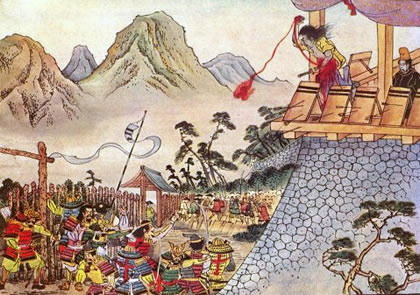 |
| Taira-Minamoto Wars |
The Taira-Minamoto wars, which led to the firm establishment of the shogunate as Japan’s military government, began in the middle of the 12th century. At this time power in Japan was almost evenly divided between two families of feudal nobility, or the daimyo class, the Taira and the Minamoto.
Save for an allegiance to the emperor, more often acknowledged tacitly rather than in reality, both families began to see Japan as a prize to be fought over. The Fujiwara clan, whom both the Taira and Minamoto sought to replace, had been a power in Japan since the seventh century, serving as regents for the imperial dynasty.
Sensing a waning of the Fujiwara’s ability to rule, the Taira and Minamoto mustered their forces. The Taira and Minamotos had one qualitative edge: Whereas the Fujiwaras were largely cultivated court nobles, the Taira and Minamoto were daimyo from the rough samurai military class, the professional warriors of Japan, who followed “the Way of the Horse and the Bow.â€
  |   |
In 1156, the first skirmishes took place in the Taira-Minamoto struggle when the clans fought in both sides of an imperial succession dispute known as the Hogen incident, named for the year it took place.
The side led by Taira Kiymori won out. Ironically he owed his place of power to Minamoto Yoshitomo, who lost his father and brother on the opposing side against the Tairas. The grief-stricken Yoshitomo declared, “A man could not live under the same heaven as the murderer of his father.â€
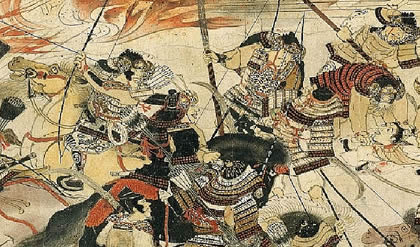 |
| some of the most brutal warfare |
In 1160 in the Heiji rebellion, named again for the year it took place, Minamoto Yoshitomo gathered his knights, his samurai, and his footsoldiers, or ashigaru. The fighting raged in the imperial capital of Kyoto and featured some of the most brutal warfare yet seen among the Japanese.
The entire capital became a battleground, in which the highlight was the Minamoto’s assault on the Sanjo Palace. In one such battle, “wild flames filled the heavens, and a tempestuous wind swept up clouds of smoke.
The nobles, courtiers, and even the ladies in waiting of the women’s quarters were shot down [by arrows] or slashed to death.†Taira Kiyomori gained the upper hand, and the bloodied Minamoto retreated east to the region around Edo, modern Tokyo.
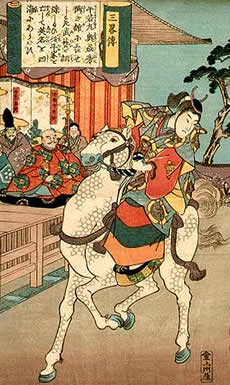 |
| Taira Kiyomori |
With the Heiji uprising thwarted, Taira Kiyomori took up residence in the capital at Kyoto. Soon the Taira lost their combative edge and evolved into effete courtiers like the Fujiwara. Kiyomori even married into the imperial family. However the Minamoto had only been biding their time.
In 1180 Emperor Takakura abdicated and Kitomori put his grandson Antonoku forward as the next emperor. However the rightful heir, Prince Mochito, issued a call to arms to support his claim to the throne. Minamoto Yorimasa rose in revolt against the Taira clan.
A large Taira force along the Uji River confronted Minamoto Yorimasa in the Gempei War. In an overwhelming charge, the Taira cavalry forded the river and Yorimasa faced defeat. Rather than surrender to the enemy, Yorimasa committed ritual suicide as his sons held off the enemy.
Yet the Minamoto, once up in arms against their old foes, would not back down. Although Yoritomo had as yet no army to support him, his plan of action offered great booty, always an inducement to the samurai class, to any who would join him in the eastern part of the country.
When Taira Kiyomori died in 1181, the hold of his clan on the country began to weaken. Two years later Yoritomo saw his chance. In 1183 he attacked. His cousin, Minamoto Yoshinaka, defeated the Taira forces at Kurikawa and again at Shinohara.
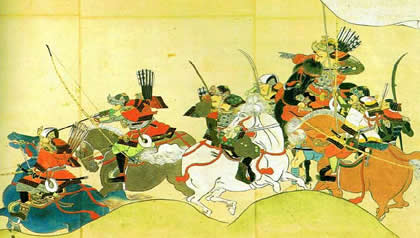 |
| Minamoto knights |
In August the Minamoto forces entered Kyoto and an agreement was reached with the retired emperor Go-Shirakawa. While the compact allowed the young Emperor Go-Toba to rule, it signaled an alliance between the imperial dynasty and the Minamoto clan.
With the Taira in full retreat under Taira Munemori, Yoritomo ordered a full pursuit: He intended a complete and decisive victory. Yoritomo’s brother Yoshitsune was given the orders to finish the Taira. The Taira sought refuge in a cliff fortress at Ichi-no-tani near Kobe.
However in a daring nighttime attack, Yoshitsune and 150 men climbed down the cliff to surprise and rout the Taira army. The Taira force was driven back to the safety of their fleet. There they sought refuge on the small island of Yashima, located off the island of Shikoku.
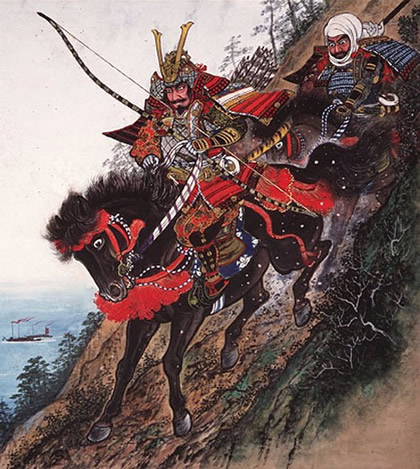 |
| Minamoto Yoshitsune |
On April 24, 1185, in one of the few decisive naval battles in Japanese history, the Minamoto and Taira fleets met off the Dan-no-Ura peninsula, where the Strait of Shimonoseki separates the islands of Honshu and Kyushu.
The battle began auspiciously for the Taira as, using the tide as a weapon, they attempted to surround the Minamoto ships. But during the battle, some of the Taira captains switched sides as Miura Yoshizumi attacked the Taira ships from the rear, and the Taira navy was defeated.
Taira Kiyomori’s widow grabbed her grandson, the young Emperor Antoku, and plunged into the water. Both were drowned. Taira daimyo followed their example, choosing death by drowning to surrender.
Antoku’s mother, who also attempted seppuku by drowning, was rescued. She was permitted to live out her life as a nun and died in 1191 at the age of 36. With the decisive defeat of the Taira, Emperor Go-Shirakawa appointed Yoritomo as shogun, the military dictator of Japan.
- Japanese Feudalism
Japanese Feudalism When most people think of feudalism, medieval Europe from about the ninth to 15th centuries is most likely to come to mind. The term feudalism is of fairly recent origin, coined in the 17th century by lawyers and antiquarians who used...
- Fujiwara Clan
Fujiwara clan symbolThe Fujiwara clan rose to power as a result of the coup d’etat of 645 that overthrew the Soga, which had dominated the Japanese government until then. The period between c. 857 and 1160 is called the Fujiwara period. Even after...
- Hojo Clan
Hojo clan symbolMembers of this Japanese family were warriors or warlords during the Kamakura Shogunate and rose to the rank of shikken (hereditary regents) from 1203 until 1333. They traced their descent from Taira Sadamori, with the founder of the family,...
- Kamakura Shogunate
Minamoto Yoritomo The Kamakura Shogunate was a government established by Kamakura Shogunate at the end of the Gempei War, which had lasted from 1180 until 1185. The shogunate lasted from 1185 (or 1192, when it was formally recognized by the emperor) until...
- Kemmu Restoration
Emperor Go-Daigo In 1185 the young Japanese emperor Antoku, some seven or eight years old, was drowned in the Battle of Dannoura in the Inland Sea by his grandmother, rather than be captured by their enemies. The power of the Taira clan, with which he...
